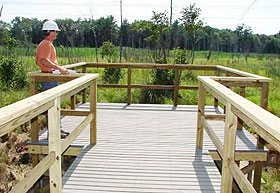  |
| HOME | THIS ISSUE | CALENDAR | GRANTS | BACK ISSUES | < BACK | NEXT > |
Conservation area established on site of former landfillby Karen A. Grava - October 22, 2007 | ||||
| A 64-acre preservation area is being built on undeveloped land on North Campus. The land comprises both wooded uplands and wetlands, including vernal pools that provide habitat for a variety of amphibians; a Great Blue Heron Rookery, which has been the nesting place for half a dozen pairs of these birds; hiking and biking trails; and boardwalks with scenic overlooks.
The preserve will be owned and maintained by UConn but the state Department of Environmental Protection (DEP) will oversee it and enforce compliance, according to a conservation agreement signed by the University and the DEP. The agreement was recently approved by the Board of Trustees. Permanent conservation of the land is one of the final requirements of the cleanup for the former UConn landfill, which has not operated as a dump since the mid-1980s. “This land will someday be a carefully managed nature preserve for outdoor enthusiasts and environmental researchers,” says Richard Miller, UConn’s director of environmental policy. The area is located between Hunting Lodge Road and North Hillside Road, north of the landfill. Plans are to create three unpaved parking spaces for the public on Hunting Lodge Road, near the utility road entrance. Additional parking for visitors will be available from North Hillside Road, at a new parking lot that will be constructed on top of the former landfill. The parking lot will open next year. “The preserve is literally trash-to-treasure,” says Miller. “We’ve unofficially dubbed the preserve the Hillside Environmental Education Park, and we’re hopeful that this area will someday be a natural jewel for the North Campus.” The preserve can be used for passive recreation, such as bird watching, hiking, and biking, and for education and research. It will have a pavilion that can be used for picnicking, several boardwalk areas that allow for study of wetlands, and two wooden observation areas – one near the Great Heron Rookery and the other near the landfill parking lot looking north into the preservation area. Kristin Schwab, associate professor of plant science, and a team of senior landscape design students determined how to make the most of the hilly site and where to connect the trails, place signs to guide and educate visitors, and maximize observation of ecosystems, plants, and wildlife. Trails that will be built into the parcel will connect with the Hunting Lodge Road entrance to Shelter Falls Park, owned by the Town of Mansfield, and the Celeron trail, as well as the dirt utility road that ends on North Hillside Road and is already by joggers and hikers. The parcel cannot be used for agriculture, forestry, or pesticide application, and no structures can be built on it. In addition, no motor vehicles, including snowmobiles, can be used on it. The landfill remediation plan requires long-term care and monitoring of natural resources affected by UConn’s clean-up activities, says Miller. It also presents interesting topics for student and faculty-led environmental research projects. For example, because the DEP required UConn to remove leachate-contaminated sediments from wetlands located along the landfill perimeter, the University must monitor the effectiveness of its efforts to restore these wetlands and create others as viable habitat for a diversity of wildlife species. Control of invasive plants, such as autumn olive and phragmites, which tend to overtake disturbed sites such as this one, will also be of interest to researchers, Miller says. Other research on the site could focus on the long-term effectiveness of remedial technologies employed in the clean-up and the resulting impacts on hydrology surrounding the former landfill. |
| ADVANCE HOME UCONN HOME |

